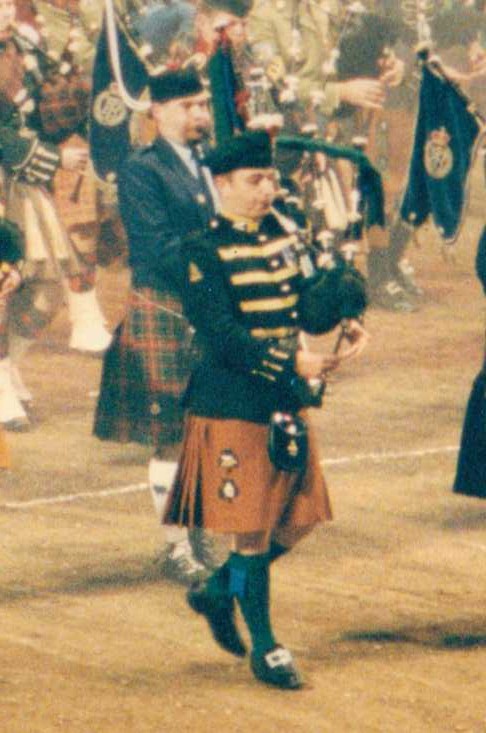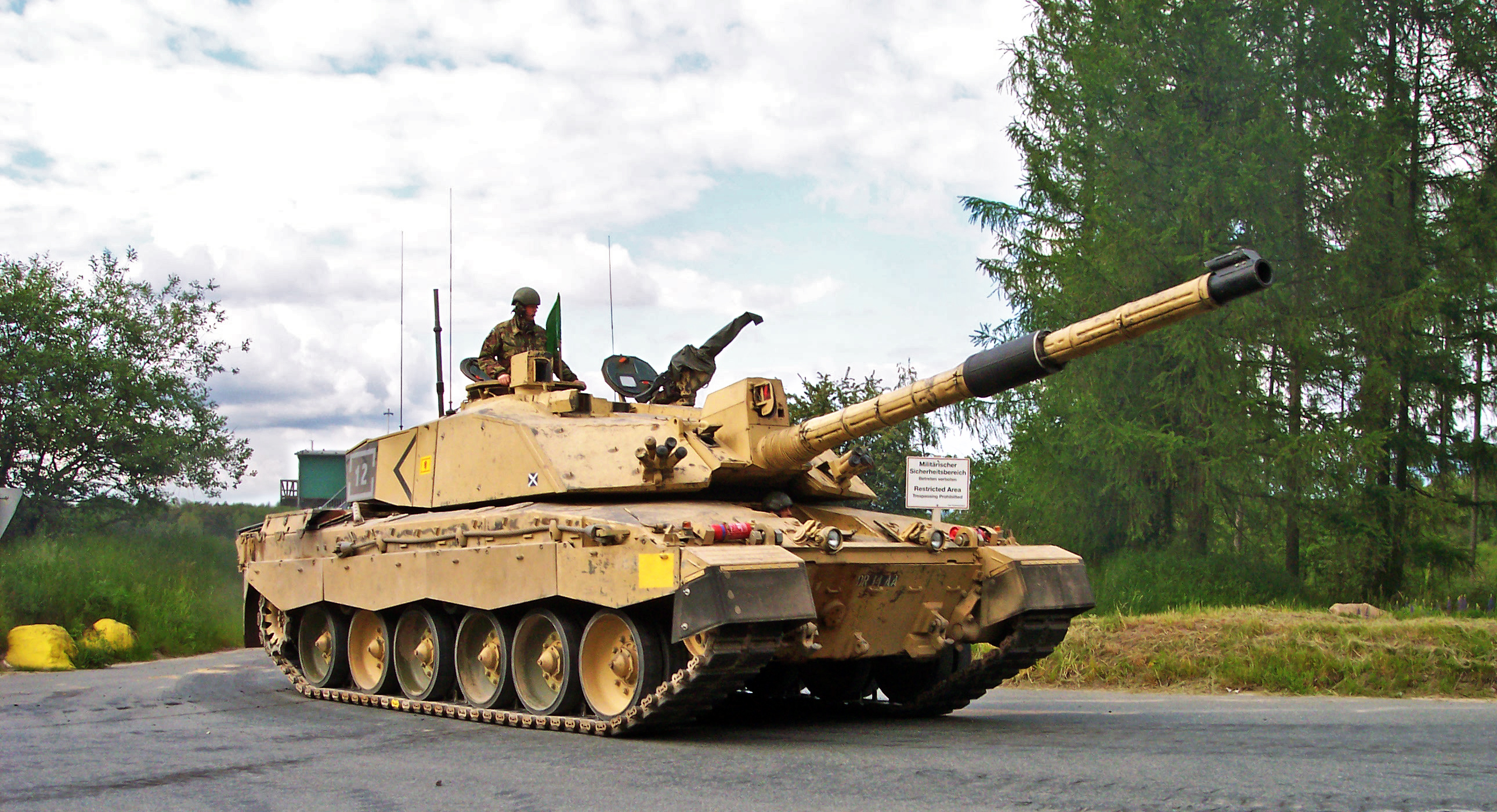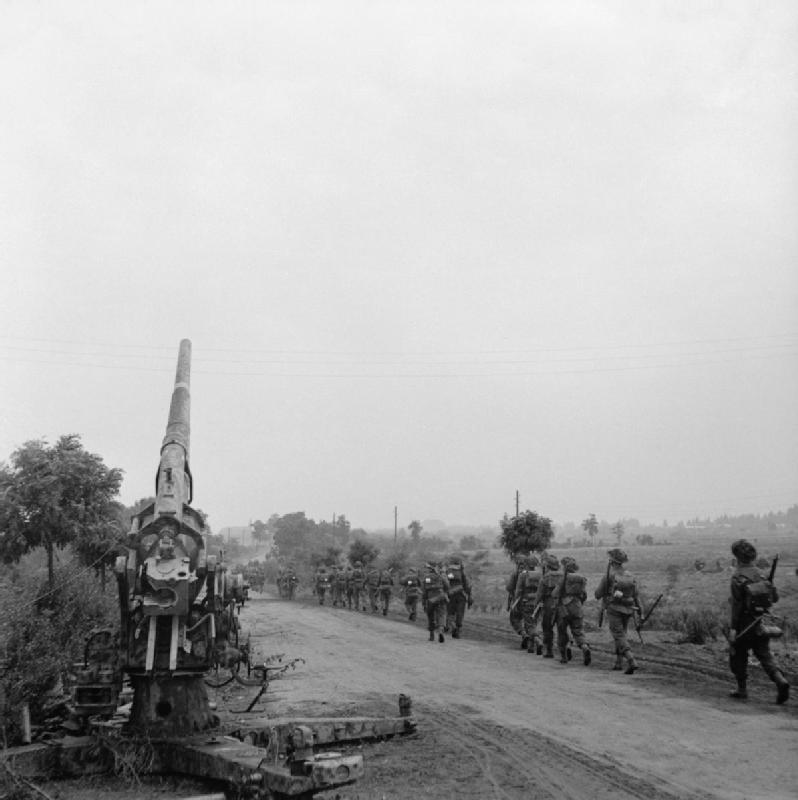|
Armoured Regiments
Armoured regiments are units provided by the Royal Armoured Corps of the British Army. History The first armoured regiments - known at the time as "tank battalions" - were formed in the First World War, first in the Machine Gun Corps and later as the Tank Corps. Each battalion had three companies, each of three sections of four tanks, for a combat strength of thirty-six tanks; a further twelve were kept in reserve for training and replacement purposes. Twenty-six battalions were formed during the war, quickly reduced to four battalions after the end of hostilities. By the late Second World War, there were four armoured regiments in each armoured division. One, the Division's Reconnaissance Regiment, was equipped with the Cromwell tank; the other three, which were in the Armoured Brigade, were equipped with the Sherman medium tank. An exception was the 7th Armoured Division's 22nd Armoured Brigade which had a mixture of Cromwells and Sherman Fireflys (Sherman fitted with 17pdr gu ... [...More Info...] [...Related Items...] OR: [Wikipedia] [Google] [Baidu] |
Royal Armoured Corps
The Royal Armoured Corps is the armoured arm of the British Army, that together with the Household Cavalry provides its armour capability, with vehicles such as the Challenger 2 and the Warrior tracked armoured vehicle. It includes most of the Army's armoured regiments, both the Royal Tank Regiment and those converted from old Cavalry regiments of the British Army, horse cavalry regiments.Forty p. 63. In September 2024, it comprised fourteen regiments: ten Regular Regiments; four Army Reserve (United Kingdom), Army Reserve. Although the Household Cavalry Regiment (the Life Guards (United Kingdom), Life Guards and the Blues and Royals) provide an armoured regiment, they are not part of the RAC. History The RAC was created on 4 April 1939, just before World War II started, by combining regiments from the List of British Army regiments (1881)#Cavalry of the Line, cavalry of the line which had mechanised with the Royal Tank Corps (renamed Royal Tank Regiment). As the war went on and ... [...More Info...] [...Related Items...] OR: [Wikipedia] [Google] [Baidu] |
The Royal Dragoon Guards
The Royal Dragoon Guards (RDG) is a cavalry regiment of the British Army. It was formed in 1992 by the amalgamation of two other regiments: The 4th/7th Royal Dragoon Guards and the 5th Royal Inniskilling Dragoon Guards. Based in Battlesbury Barracks, Wiltshire, the unit currently serves as the armoured cavalry reconnaissance regiment of 20th Armoured Brigade Combat Team. The regiment is equipped with the Warrior armoured fighting vehicle, and is transitioning to the new Ajax vehicle. History The regiment was formed in 1992 by the amalgamation of two other regiments: The 4th/7th Royal Dragoon Guards and the 5th Royal Inniskilling Dragoon Guards. The Royal Dragoon Guards has served in a variety of roles and theatres since its formation. Historically dragoons were flexible soldiers, who fought on and alongside their mounts. Northern Ireland In February 1996, three squadrons of the regiment deployed to Northern Ireland as part of Operation Banner, the UK military support to ... [...More Info...] [...Related Items...] OR: [Wikipedia] [Google] [Baidu] |
20th Armoured Brigade Combat Team (United Kingdom)
The 20th Armoured Brigade Combat Team, previously the 20th Armoured Infantry Brigade, is an Mechanized infantry, armoured infantry brigade formation of the British Army, currently headquartered at Wing Barracks, Bulford, Wiltshire, as part of the 3rd (United Kingdom) Division. History Cold War On 15 September 1950, the 20th Armoured Brigade was reformed in the UK for a strategic reserve role. However, the brigade was moved to Münster, Germany in December 1951 to supplement the British contribution to NATO forces in Europe, where it again came under the command of 6th Armoured Division, this time as part of the British Army of the Rhine (BAOR). The 1957 Defence White Paper announced the end of National Service, resulting in a number of reductions and changes across the armed forces. Part of this restructuring saw the disbandment of the 6th Armoured Division in April 1958. The Brigade survived as the new 20th Armoured Brigade Group, initially under the command of the 4th Infan ... [...More Info...] [...Related Items...] OR: [Wikipedia] [Google] [Baidu] |
Queen's Royal Hussars
The Queen's Royal Hussars (The Queen's Own and Royal Irish) (QRH) is the most senior armoured regiment in the British Army, equipped with Challenger 2 main battle tanks. The regiment was formed on 1 September 1993 from the amalgamation of the Queen's Own Hussars and the Queen's Royal Irish Hussars. The regiment and its antecedents have been awarded 172 Battle Honours and eight Victoria Crosses. The regiment was based in Sennelager, Germany, until 2019 when it was relocated to Tidworth Camp, England. The Queen's Royal Hussars serves as the armoured regiment for the 20th Armoured Brigade Combat Team. History The Queen's Royal Hussars was formed in Fallingbostel on 1 September 1993 from the amalgamation of the Queen's Own Hussars and the Queen's Royal Irish Hussars. Home Headquarters was formed shortly thereafter at Regent's Park Barracks in London where it remains today. After the amalgamation, the regiment became the cavalry of the following areas: Northern Ireland, Warwicksh ... [...More Info...] [...Related Items...] OR: [Wikipedia] [Google] [Baidu] |
King's Royal Hussars
The King's Royal Hussars (KRH) is an armoured regiment of the British Army formed in 1992. Based at Tidworth it serves as one of the armoured regiments of the 12th Armoured Brigade Combat Team (ABCT). History The regiment was formed on 4 December 1992 by the amalgamation of two other regiments: * The Royal Hussars (Prince of Wales's Own) (an amalgamation of the 10th Royal Hussars (Prince of Wales's Own) and 11th Hussars (Prince Albert's Own)) and * 14th/20th King's Hussars (an amalgamation of the 14th King's Hussars and 20th Hussars). Deployments The regiment was based at York Barracks in Münster at the time of amalgamation from where it deployed units to Northern Ireland on Operation Banner in June 1994 and to Bosnia and Herzegovina in January 1996. The regiment deployed units to Bosnia and Herzegovina again in June 1997 and to both Bosnia and Herzegovina and Kosovo in autumn 1999. The regiment returned to Aliwal Barracks at Tidworth Camp in March 2000 from where i ... [...More Info...] [...Related Items...] OR: [Wikipedia] [Google] [Baidu] |
12th Armoured Brigade Combat Team (United Kingdom)
The 12th Armoured Brigade Combat Team, formerly the 12th Armoured Infantry Brigade, is a regular brigade of the British Army which has been in almost continuous existence since 1899 and now forms part of 3rd (United Kingdom) Division. History Second Boer War British Army brigades had traditionally been ''ad hoc'' formations known by the name of their commander or numbered as part of a division. However, units involved in the Second Boer War in 1899 were organised into sequentially numbered brigades that were frequently reassigned between divisions. 6th Division, consisting of the 12th and 13th Brigades, was formed on 30 November and landed in South Africa during January 1900. It was moved up to Nauwpoort, from where 12th Brigade under the command of Major-General R.A.P. Clements was pushed forward to reinforce the Cavalry Division. When the field force was reorganised after the capture of Bloemfontein, 12th Brigade returned to the command of 6th Division. The brigade saw actio ... [...More Info...] [...Related Items...] OR: [Wikipedia] [Google] [Baidu] |
Challenger 2
The FV4034 Challenger 2 (MoD designation "CR2") is a third generation British main battle tank (MBT) in service with the armies of the United Kingdom, Oman, and Ukraine. It was designed by Vickers Defence Systems (now Rheinmetall BAE Systems Land (RBSL)) as a private venture in 1986, and was an extensive redesign of the company's earlier Challenger 1 tank. The Ministry of Defence ordered a prototype in December 1988. The Challenger 2 has four crew members consisting of a commander, gunner, loader, and driver. The main armament is a L30A1 rifled tank gun, an improved derivative of the L11 gun used on the Chieftain and Challenger 1. Fifty rounds of ammunition are carried for the main armament, alongside 4,200 rounds of 7.62 mm ammunition for the tank's secondary weapons: a L94A1 EX-34 chain gun mounted coaxially, and a L37A2 (GPMG) machine gun. The turret and hull are protected with second generation Chobham armour, also known as Dorchester. Powered by a Perkins ... [...More Info...] [...Related Items...] OR: [Wikipedia] [Google] [Baidu] |
1st Royal Tank Regiment
The 1st Royal Tank Regiment (1 RTR) was an armoured regiment of the British Army. It is part of the Royal Tank Regiment, itself part of the Royal Armoured Corps and operationally under 12th Armoured Infantry Brigade. History Formation The regiment was originally formed as A Company, Heavy Section, Machine Gun Corps in May 1916 during the First World War (1914–1918). It took part in the first ever tank offensive in 1916 and saw action on the Western Front again in the Battle of Cambrai in November 1917 and later in the Hundred Days Offensive. Remaining active in the army during the interwar period, in 1939 it was renamed the 1st Royal Tank Regiment. Second World War During the Second World War (1939–1945) the regiment took part in the Siege of Tobruk in the summer of 1941 and the Battle of El Alamein in October 1942, the advance up Italy in late 1943, the Normandy landings in June 1944 and the Western Allied invasion of Germany in 1945. From the Battle of El Alamei ... [...More Info...] [...Related Items...] OR: [Wikipedia] [Google] [Baidu] |
Royal Mercian And Lancastrian Yeomanry
The Royal Mercian and Lancastrian Yeomanry was a yeomanry regiment of the United Kingdom's Territorial Army. It served in the armoured replacement role, providing replacement tank crews for regular armoured regiments. History The regiment was formed in November 1992 by the amalgamation of The Queen's Own Mercian Yeomanry and The Duke of Lancaster's Own Yeomanry as part of the Options for Change. In 1999, it absorbed a squadron from The Queen's Own Yeomanry, bringing it to a strength of four squadrons plus the headquarters squadron.The Royal Mercian and Lancastrian Yeomanry regiments.org In October 2006, the RMLY became a single cap badge regiment, when the individual cap badges of each squadron were replaced by the newly designed RMLY cap badge. This incorporated the Merci ... [...More Info...] [...Related Items...] OR: [Wikipedia] [Google] [Baidu] |
Royal Wessex Yeomanry
The Royal Wessex Yeomanry (RWxY) is a reserve armoured regiment of the British Army consisting of five squadrons, with the regimental headquarters based at Bovington Camp, Dorset. The regiment is part of 3rd (UK) Division and provides battle casualty replacements to the three armoured (Challenger 2) regiments. Under the Future Soldier reforms, the regiment now comes under the command of 12th Armoured Brigade Combat Team. History The regiment can trace its history back to 4 June 1794, when a meeting of country gentlemen at the Bear Inn in Devizes decided to raise a body of ten independent troops of yeomanry for the county of Wiltshire, which became the Royal Wiltshire Yeomanry. The Wessex Yeomanry was formed on 1 April 1971 by re-raising cadres from the Royal Wiltshire Yeomanry, the Royal Gloucestershire Hussars and the Royal Devon Yeomanry to form four squadrons. The Wessex Yeomanry was granted its royal title, becoming the Royal Wessex Yeomanry, on 8 June 1979. Initially ... [...More Info...] [...Related Items...] OR: [Wikipedia] [Google] [Baidu] |
Territorial Army (United Kingdom)
The Army Reserve is the active-duty volunteer reserve force of the British Army. It is separate from the Regular Reserve (United Kingdom), Regular Reserve whose members are ex-Regular personnel who retain a statutory liability for service. Descended from the Territorial Force (1908 to 1921), the Army Reserve was known as the Territorial Army (TA) from 1921 to 1967 and again from 1979 to 2014, and the Territorial and Army Volunteer Reserve (TAVR) from 1967 to 1979. The force was created in 1908 by the Secretary of State for War, Richard Haldane, 1st Viscount Haldane, Richard Haldane, when the Territorial and Reserve Forces Act 1907 combined the previously civilian-administered Volunteer Force, with the mounted Yeomanry (at the same time the Militia#United Kingdom, Militia was renamed the Special Reserve). Haldane planned a volunteer "Territorial Force", to provide a second line for the six divisions of the British Expeditionary Force (First World War), Expeditionary Force which h ... [...More Info...] [...Related Items...] OR: [Wikipedia] [Google] [Baidu] |
The Royal Scots Dragoon Guards (Carabiniers And Greys)
The Royal Scots Dragoon Guards (Carabiniers and Greys) is a light Cavalry regiments of the British Army, cavalry regiment of the British Army, and the senior Scottish regiment. The regiment, through the Royal Scots Greys, is the oldest surviving Line regiment#Cavalry, Cavalry Regiment of the Line in the British Army. The regiment is based at Waterloo Lines, Leuchars Station, and forms part of the 7th Light Mechanised Brigade Combat Team. History The Royal Scots Dragoon Guards were formed on 2 July 1971 at Holyrood, Edinburgh, by the amalgamation of the 3rd Carabiniers, 3rd Carabiniers (Prince of Wales's Dragoon Guards) (themselves the product of the amalgamation in 1922 of 3rd Dragoon Guards, 3rd Dragoon Guards (Prince of Wales's) and Carabiniers (6th Dragoon Guards), 6th Dragoon Guards (Carabiniers), and Royal Scots Greys, The Royal Scots Greys (2nd Dragoons). Soon after, the regiment deployed on four tours of Northern Ireland in 1972, 1974, 1976 and 1980, suffering one fatal ... [...More Info...] [...Related Items...] OR: [Wikipedia] [Google] [Baidu] |







